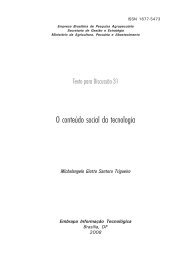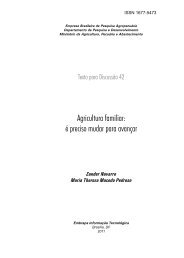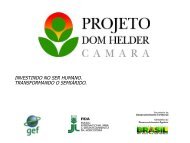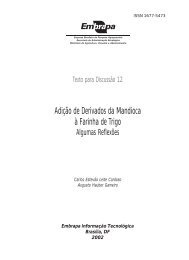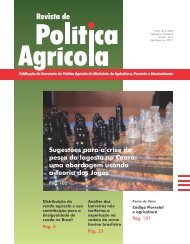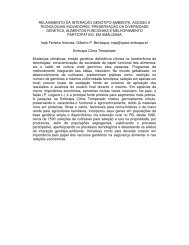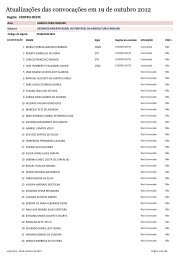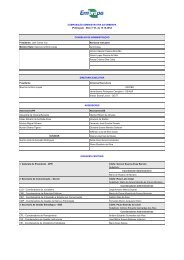Ministry of Agriculture, Livestock and Food Supply - Embrapa
Ministry of Agriculture, Livestock and Food Supply - Embrapa
Ministry of Agriculture, Livestock and Food Supply - Embrapa
You also want an ePaper? Increase the reach of your titles
YUMPU automatically turns print PDFs into web optimized ePapers that Google loves.
Production <strong>and</strong> productivity indicators<br />
World wood consumption increased to 3.3-billion m3 /year in the mid<br />
1990s. The area <strong>of</strong> the world covered with forests was 3.41-billion hectares in<br />
1995, or 27% <strong>of</strong> the Earth surface, excluding Greenl<strong>and</strong> <strong>and</strong> Alaska. At the<br />
time Brazil accounted for 16% <strong>of</strong> forests. The area doubled from 40.2-million<br />
to 81.2-million hectares during the 1980-1995 period, from 40.2-million to 81.2million<br />
hectares.<br />
Industrial consumption <strong>of</strong> firewood for energy purposes is concentrated<br />
in the agro-industries located in rural areas, where firewood is used mainly in<br />
drying grain, tea or tobacco; producing bricks; <strong>and</strong> the ceramics industry.<br />
These uses account for 10%-20% <strong>of</strong> the wood energy obtained in Asia <strong>and</strong><br />
9.5%, in Africa. Charcoal is used in larger industries. The Brazilian annual<br />
charcoal consumption is estimated at 6-million tons, especially in the steel<br />
<strong>and</strong> other metal alloy industries.<br />
Charcoal <strong>and</strong> other types <strong>of</strong> wood energy are used so widely because <strong>of</strong><br />
the low cost <strong>and</strong> availability <strong>of</strong> wood, particularly in rural areas. As a rule it is an<br />
extractive process in which production <strong>and</strong> processing costs are negligible.<br />
Preference is explained by charcoal's ease <strong>of</strong> transportation <strong>and</strong> combustion.<br />
According to FAO, Brazil's forests cover 5.3-million km2 or two-thirds <strong>of</strong><br />
the total area <strong>of</strong> the country <strong>and</strong> are the second largest in the world, after the<br />
Russian Federation's.<br />
Brazil consumes 300-million m3 /year <strong>of</strong> wood, <strong>of</strong> which 100-million m3 /<br />
year come from forests planted for industrial purposes. Industrial consumption<br />
in 2001 was estimated at 166-million m3 /year, including 32-million m3 for paper<br />
<strong>and</strong> cellulose; 45-million m3 for charcoal; 29-million m3 for industrial firewood;<br />
<strong>and</strong> 60-million m3 for solid products (saw logs, boards, plywood, panels, etc.).<br />
The role played by planted forests has grown substantially in Brazil in the<br />
last few years. In the paper <strong>and</strong> cellulose industry 100% <strong>of</strong> the wood used comes<br />
from reforestation projects. In the charcoal industry the share <strong>of</strong> planted forests<br />
grew from 34% to 44% <strong>and</strong> in solid product industry, from 28% to 44% from 1999<br />
to 2000. The area covered with planted forest is estimated that 6.4-million hectares<br />
in Brazil, <strong>of</strong> which 4.8-million hectares are planted with eucalyptus <strong>and</strong> pinus <strong>and</strong><br />
almost 2.6-million hectares more with interspersed native forests.<br />
The average eucalyptus yield was 36 m 3 /ha/year in São Paulo in 2000.<br />
When three 6-year cycles were considered, productivity increased to 44.8<br />
m 3 /ha/year. Estimates indicate 50-60 m 3 /ha/year averages in the near future.<br />
92



